Here is as good a collection of pre-1800 maps of Mauritius as I have been able to put together. If you have others (or even better quality versions of the same), please leave a comment below and I will update the page accordingly, thanks!
1601 – Gelderland
The Dutch colonized Mauritius (quoth Wikipedia): landing in 1598, they initially named the Island after Prince Mauritz of Nassau (hence “Maurice” and “Mauritius”). However, when in 1615 governor Pieter Both was shipwrecked and killed on his way back “from India with four richly-laden ships in the bay”, Dutch sentiment shifted against the island, thinking it was “cursed”.
This is a map of a bay in the southwest of Mauritius, drawn from aboard the Dutch ship the Gelderland.
This is historically notable because it mentions dodos, which almost certainly gets ornithology historians a-twitching (in a nice way, I’m sure).
1659 – Johann Blaeu
This early (but modestly-sized and almost impossible to recognize) map was printed in Amsterdam in 1659 as part of Johann Blaeu’s “Nuevo Atlas o Teatro del Mundo”:
Mysteriously, the auction site where I found this scannotes that this was printed on the reverse side of a map of “Vaygach Island” (in Russia), when it is actually of Staten Island (next to Hollandia Nova). Oh well! *sigh*
16xx – Portolan
A very early (but undated) Portolan map of the island, courtesy of Harold and Maryse.
1702-1707 – John Thornton
This is “A chart of the Island of MAURITIUS” by John Thornton: and though it was reprinted a number of times during the 18th century, it was first drawn between 1702 and 1707.
This scan was from NYPL, who have very kindly posted up an even higher resolution TIFF image of it if you want to download that.
Note that North is to the right, so Mauritius’ modern-day Black River district sits across the top left edge of the map, though few (English-language) landmarks here have names recognizable to a modern cartographer. Barely any internal details of the island are filled in: all in all, it’s more of an outline than a map.
1726 – François Valentijn
Here’s an early Dutch map of Mauritius, which this seller calls “the earliest large map of the island”. The cartography seems a bit suspect to my eyes, but perhaps others will disagree:
17xx – Jean-Baptiste Bourguignon d’Anville
This undated map of Mauritius was allegedly drawn for Monsieur de Noyon, who was (it says here) the Governor of the island (though I’m not sure about this myself). I found it on Harold and Maryse’s site, in their nice collection of old maps of Mauritius.
1751 – Jean-Baptiste-Nicolas-Denis d’Apres de Mannevillette
This next map is “Plan de l’Isle de France, suivant les observations de M. D’Après de Mannevillette” by Nicolas-Louis de La Caille (1713-1762), which you can download from Buchfreund, while the matching bibliographic detail is on Gallica.
Once again, North is to the right: but some rivers, internal details and many modern names are now visible – la Riviere Noire, Flic en Flac, and so forth. Nice quality draughting, but still somewhat sketchy.
1753 – Van Keulen
Here’s a Dutch map of part of the coast dating to 1753:
1764 – J.N. Bellin (Part 1)
Bellin was the Hydrographer at the Depot de la Marine: I found this copy courtesy of Harold and Maryse’s site.
1764 – J.N. Bellin (Part 2)
Bellin adapted his map for the Duc de Choiseul, adding a few useful extra cartographic bits round the edges:
Once again, this was courtesy of Harold and Maryse’s nice site.
1781 – John Lodge
A handwritten note added at the top of the full map from which this was cropped (courtesy of the Norman B. Leventhal Map Center at the Boston Public Library) says: “Cut from The Political magazine, London 1781, vol. 2, p.545”. Note the best map ever drawn, for sure, but it is what it is:
1788 – Rigobert Bonne (First Map)
Rigobert Bonne (1727-1795) was a French engineer and cartographer who was the Hydrographer at the Depot de la Marine after J.N. Bellin. This map was a part of “Cartes générale et particulières des Isles de France, de Bourbon et de Rodrigue” (a good copy is here, courtesy of DePaul University), and appeared in a number of places, such as Abbé Guillaume-Thomas-François Raynal’s “Atlas de Toutes Les Parties Connues de Globe Terrestre”, and Bonne’s own “Atlas Encyclopédique” (2 volumes, 1787-88).
Even though this is recognizably Mauritius and Bonne has obviously tried to develop a topographical angle (by adding mountains), there’s not a lot of named detail: hence this seems to have been drawn independently of la Caille’s 1751 map and even possibly of Bellin’s 1764 map(s).
1791 – Rigobert Bonne (Second Map)
It’s hard to say whether this is genuinely a second Bonne map, or just a kind of merging (say) of the toponymic detail from La Caille’s 1751 map into Bonne’s first map of 1788. There’s a good quality scan downloadable courtesy of Wikipedia.
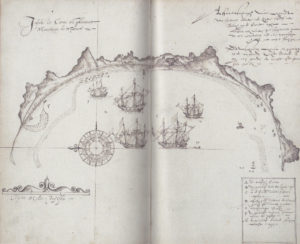
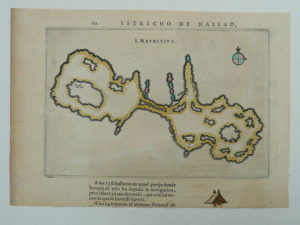
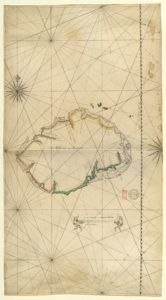

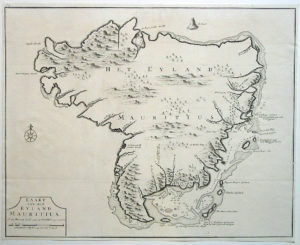
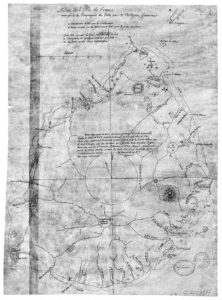



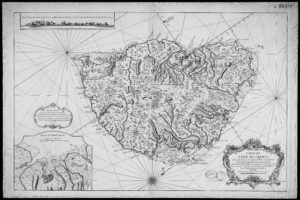


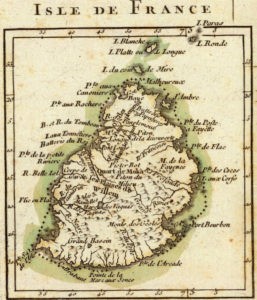
How to ship to maps to you?
1st is a detailed map of port Louis 1771 & 1775
2nd is a detailed map of the island
Hope you have a cracking adventure.
(Sigh) ….”two” maps ….
Not doing very well here …. 2nd map is from 1801
Rookie observer: I have the Port Louis map already, and will add that during tomorrow. I like the way it names various shipwrecks in the harbour. 🙂
The great navigator and cartographer Matthew Flinders was detained as a POW on Mauritius for seven years (1803-1810). It is possible that his papers will mention matters of interest to us.
Topsy-turvy and backwards — which is the closest to the ‘correct cartography ?
Not to mention which map was made from actual observation of the island and its terrain. Do you have the full name and ‘home-country’ of each of the mapmakers?
Still 1-dring — about a lot of things!
bd
Some others links : http://blog.airmauritius.com/fr/the-story-of-mauritius-in-maps/#!prettyPhoto
Christophe: thanks very much, I’ve added both of those maps in (though I have to say that the Blaeu map doesn’t look even remotely like Mauritius, truth be told, *sigh*). 🙂
@Nick:
A very large paperback book; title : Maps of the Ancient Sea Kings — Charles H. Hapgood — page 277 — item 17. Mauritius:
True Location 20.0 S 57.0 E
Portuguese Map: 23-24 S 78,0 E
Errors: 3.5 S 21.0 E
This is a very large volume of Geographical Tables
I’ve had this book for quite a while (at least as far back as when we were discussing the Vikings). There are several very interesting ‘words of appreciation’ from Mr. Hapgood, with a dedication to Captain Arlington H. Mallery .
Published by :
Adventures Unlimitted Press
One Adventure Place
Kempton, Illinois 60946 USA
ISBN 0-932813-42-9
Byron: Matthew Flinders’ journal (and his frosty relations with Decaen) looks to be a fascinating read, but one that’s a little out of my book-buying budget, particularly now that I’ve ended up with so many books about the Atlantis raider. 🙂
So, Nick: If the reference to Staten Island should be what was first a Dutch colony, which was eventually overwhelmed by the British — perhaps some Mariners maps may meet and mention the presence of the Dutch also on Long Islandt , as well as the settlements along creeks such as Beverwyck . The British, in particular, were very interested in finding the source supply of beaver furs — to be made into the hats (top hats) which were worn whenever London gentlemen were out and about for social events.
At one point in British history, several North American Indian Chiefs visited your Queen. Somewhere in your British historical archives, you should be able to find the paintings which commemorate their visit.
bd
Those same “Indians” were supposedly responsible for the massacre at Fort Schenectady. Some historians believe that the killers were local land owners competing for some of the more desirable plots of land along the river.
You may find some interesting history with my mention of Rensaellerswyck.
bd
@ B. Deveson: Please forgive my rude interruption of your earlier post. Proceed, if you will….we’ve always have gotten very interesting observations from you.
bd
Nick,
Matthew Flinders was released from Mauritius in 1810 and I would think it would be certain that he would have been debriefed by the British naval authorities regarding all matters to do with Mauritius, particularly cartographic matters, when the Napoleonic wars resumed. I would expect there would be files containing Flinders’ observations regarding Mauritius in the PRO archives – somewhere.
Byron: the National Archives in Kew has quite a few 19th century maps of Mauritius (primarily because the British had a number of army bases and coastal batteries after it took over the island in 1810), which I’m hoping to go and see very shortly.
There are quite a few letters etc from Matthew Flinders spread across UK archives (Natural History Museum, Lincolnshire Archives, and so forth), but I suspect the first place to start would be with reading his journal. 🙂
Nick & Byron:
We have a “folk song” (with a date and all) : “The Battle of New Orleans”. The lyrics, which I only partially remember a few verses:
In 1819 we took a little trip –
Along the Mississippi in a mighty big ship
We took a little bacon and we took a little beans,
‘Til we reached the town of New Orleans
We fired our cannons until the metal melted down …..
We grabbed and alligator and fought another round…..
I learned this folk- song some fifty years ago. Fun!
bd
Re your 1649 Blau – the strait between Vaygach Island and Novaya Zemlya, off the north coast of Russia, used to be called the Nassau Strait or the Weigatz Strait (see the map of Vaygach on Catawiki that you refer to), so I’m guessing that this is a map of a different Mauritius in the Arctic. Quite where exactly it is or what the island is called now, I have no idea, but I suspect the name Mavrikiya Cape (the northern tip of Novaya Zemlya) is somehow related. This area was explored by the Dutch and used to be called New Holland.
Thanks for doing this work! Very helpful!
I have a page of pirate primary sources on my website at http://baylusbrooks.com that you may find useful.. there’s also an East Indies page attached, too.